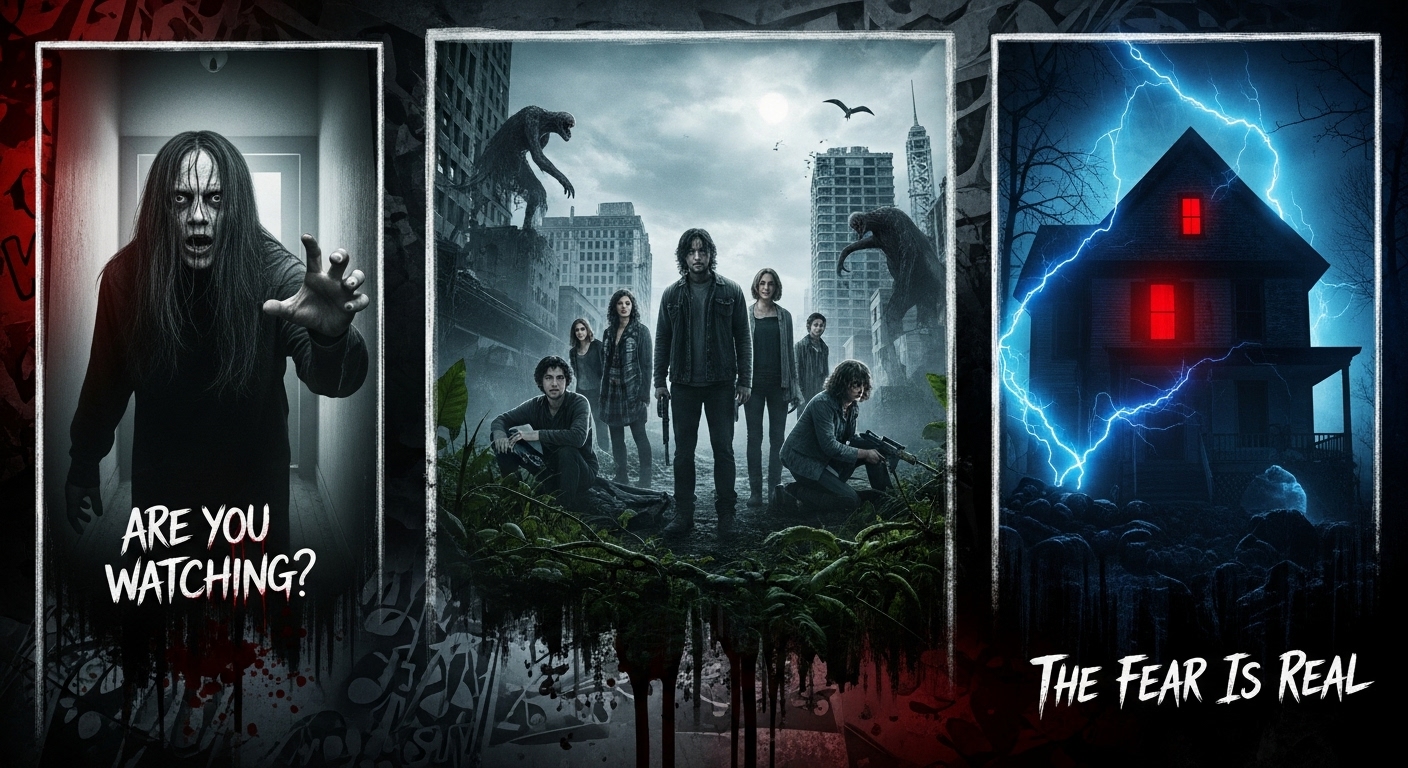Introduction
Horror as a genre has fascinated audiences for generations. While movies often dominate discussions of fear, suspense, and terror, television has quietly built its own legacy of horror storytelling. From eerie anthologies to long-running supernatural dramas and modern psychological thrillers, horror TV shows have carved a special place in popular culture.
The beauty of horror on television lies in its ability to unfold slowly, creating atmosphere, suspense, and deep character development over time. Instead of a two-hour film, TV horror can build dread across multiple episodes or even seasons, keeping audiences invested while exploring themes of mortality, the supernatural, and human psychology.
In this blog post, we will review some of the best horror TV shows of all time, looking at what made them terrifying, iconic, and unforgettable.
The Classics of Horror Television
The Twilight Zone
Rod Serling’s The Twilight Zone is one of the most influential television series ever made. While it is often categorized as science fiction and fantasy, many episodes veer into the realm of horror. Stories of paranoia, alien invasions, and existential dread gave viewers nightmares while also reflecting social and political anxieties of the time.
What made The Twilight Zone stand out was its ability to combine scares with intellectual themes. Episodes like “Nightmare at 20,000 Feet” or “The Monsters Are Due on Maple Street” demonstrated how fear could be both supernatural and psychological. The show’s lasting impact on television cannot be overstated, as it set the standard for anthology horror and influenced countless creators.
Dark Shadows
Premiering in the 1960s, Dark Shadows was a gothic soap opera that introduced mainstream audiences to vampires, witches, and ghosts on daytime television. Its most famous character, Barnabas Collins, became an icon of horror TV.
While the production values were modest, the storytelling, atmosphere, and gothic setting made it captivating. Dark Shadows helped pave the way for supernatural horror on television, proving audiences were ready for serialized gothic tales.
Anthology Horror Shows
Tales from the Crypt
In the late 1980s and early 1990s, Tales from the Crypt brought gruesome horror stories to the small screen. Hosted by the ghoulish Crypt Keeper, each episode delivered a self-contained tale of terror, often ending with a darkly ironic twist.
What made the show memorable was its unapologetic embrace of gore, camp, and humor. While not always terrifying, it reveled in the grotesque and became a cult favorite. Many famous actors and directors contributed to episodes, elevating it into a showcase of horror creativity.
American Horror Story
Ryan Murphy’s American Horror Story redefined anthology horror for modern audiences. Each season told a new story, from haunted houses to asylums, freak shows, cults, and even apocalyptic nightmares.
The show thrived on bold storytelling, striking visuals, and a rotating cast of actors taking on new roles each season. While its quality varied, its ambition and creativity made it one of the most talked-about horror shows of its time. It proved horror could dominate mainstream TV while experimenting with themes of sexuality, politics, and morality.
Creepshow
Based on the classic horror films created by George A. Romero and Stephen King, Creepshow brought comic-book style horror to television. Each episode featured multiple short stories, paying tribute to the EC Comics of the 1950s.
With its blend of campy humor, over-the-top scares, and classic monster tales, Creepshow became a favorite for fans who enjoyed traditional horror storytelling in bite-sized doses.
Supernatural Horror and Long-Running Franchises
The X-Files
While primarily known as a science fiction series, The X-Files delivered some of the most terrifying horror episodes ever seen on television. Agents Mulder and Scully investigated paranormal mysteries, ranging from alien conspiracies to urban legends and grotesque monsters.
Episodes like “Home,” featuring a horrifying family of inbred killers, remain infamous for their disturbing content. The blend of investigative drama, horror, and supernatural intrigue made The X-Files one of the defining shows of the 1990s, appealing to both horror fans and mainstream audiences.
Buffy the Vampire Slayer
Joss Whedon’s Buffy the Vampire Slayer combined teen drama with supernatural horror. While often funny and heartfelt, the show did not shy away from genuine terror. From vampires and demons to The Gentlemen in the episode “Hush,” Buffy’s world was filled with terrifying creatures.
What set Buffy apart was its emotional depth. The monsters often represented real-world fears, like loss, growing up, and loneliness. By blending horror with humor and heart, Buffy became a cultural phenomenon and one of the most enduring supernatural shows ever made.
Supernatural
For fifteen seasons, Supernatural followed brothers Sam and Dean Winchester as they hunted ghosts, demons, and monsters. Starting as a horror-of-the-week show, it eventually expanded into a sprawling mythos about Heaven, Hell, angels, and cosmic battles.
The early seasons leaned heavily into classic horror storytelling, with episodes inspired by urban legends like Bloody Mary or the Hook Man. Its combination of horror, action, and family drama made it one of the most beloved genre shows in television history.
Modern Psychological and Atmospheric Horror
The Haunting of Hill House
Mike Flanagan’s The Haunting of Hill House became an instant classic when it premiered. Based loosely on Shirley Jackson’s novel, the series blended ghost story horror with a deeply emotional family drama.
Its scares were both traditional and innovative. Hidden ghosts appeared in the background of scenes, while episodes like “The Bent-Neck Lady” shocked audiences with their twists. But beyond the scares, it was the show’s meditation on grief, trauma, and family bonds that made it unforgettable.
The Haunting of Bly Manor
The spiritual successor to Hill House, The Haunting of Bly Manor took inspiration from Henry James’s The Turn of the Screw. While less terrifying than its predecessor, it excelled in gothic atmosphere and emotional storytelling.
With themes of love, loss, and memory, it showed how horror could be deeply human and heartbreaking. It may not have delivered as many jump scares, but it reinforced Flanagan’s reputation as a master of modern horror television.
Midnight Mass
Another Mike Flanagan masterpiece, Midnight Mass explored religious horror in a small island community. Its chilling story of faith, fanaticism, and vampiric terror resonated deeply with audiences.
What made Midnight Mass powerful was its philosophical depth, with long conversations about belief, death, and morality juxtaposed with shocking horror imagery. It was a slow burn that left a lasting impression, cementing itself as one of the most unique modern horror series.
Unique Horror Concepts
Penny Dreadful
Penny Dreadful brought together classic literary characters like Frankenstein, Dracula, and Dorian Gray into a gothic horror tapestry. With its lush visuals and dark atmosphere, it was as much a character study as it was a horror series.
Eva Green’s performance as Vanessa Ives remains one of the highlights of modern horror television. The show combined supernatural terror with psychological and existential dread, making it stand out as a sophisticated piece of horror storytelling.
Channel Zero
An underrated gem, Channel Zero adapted internet “creepypasta” stories into haunting television seasons. Each season stood alone, covering tales like “Candle Cove” and “No-End House.”
Its surreal imagery and nightmarish atmosphere made it uniquely unsettling. Unlike more mainstream horror shows, Channel Zero leaned into experimental storytelling, creating a disorienting experience that stuck with viewers long after the credits rolled.
Stranger Things
Though often described as a blend of science fiction and nostalgia, Stranger Things also thrives as a horror series. Its monsters from the Upside Down, including the Demogorgon and the Mind Flayer, evoke classic creature horror.
Its strength lies in balancing horror with heartfelt storytelling about friendship, family, and growing up. The blend of 1980s nostalgia, supernatural terror, and emotional character arcs made it one of the most popular horror-adjacent shows of the modern era.
International Horror Shows
Kingdom
From South Korea, Kingdom offered a fresh take on the zombie genre. Set in medieval Korea, the series combined political intrigue with terrifying zombie outbreaks. Its stunning visuals, historical setting, and relentless suspense distinguished it from other zombie shows.
By merging period drama with horror, Kingdom showed the versatility of the genre and introduced global audiences to Korean storytelling traditions.
Marianne
A French series, Marianne delivered chilling supernatural horror. Following a horror novelist who realizes her creations are coming to life, the show balanced psychological dread with terrifying supernatural encounters.
Though short-lived, it left a strong impact with its atmosphere and inventive scares, earning a place among modern international horror gems.
Why Horror TV Thrives
Horror television succeeds because it has the time and space to explore themes that movies cannot always fully capture. Shows like The Haunting of Hill House or American Horror Story develop characters, relationships, and psychological tension across episodes, making the scares more impactful.
Additionally, horror television allows experimentation. From anthologies to serialized dramas, the format gives creators the flexibility to try new concepts, settings, and styles. Whether grounded in supernatural folklore or psychological terror, horror TV continues to evolve and captivate audiences.
Conclusion
From the groundbreaking classics like The Twilight Zone to modern masterpieces like The Haunting of Hill House, horror television has proven itself as a powerful medium for fear, suspense, and storytelling. The best horror shows go beyond jump scares, exploring the human condition, morality, and the things that haunt us both literally and metaphorically.
Horror TV thrives because it taps into universal fears while keeping us entertained, surprised, and emotionally engaged. As the genre continues to evolve, new shows will undoubtedly emerge to terrify and inspire, but the legacy of these iconic series will always remain.
For fans of fear, there has never been a better time to embrace the darkness and enjoy the chilling brilliance of horror television.


